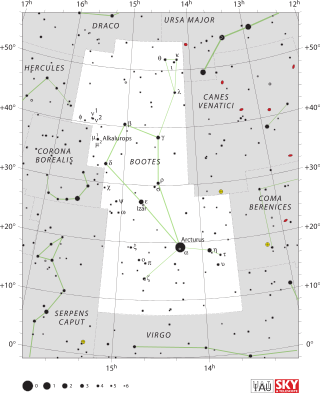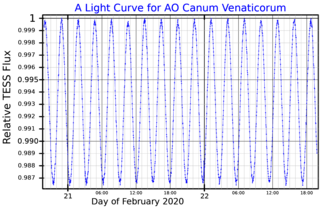
Kappa1 Sagittarii (κ1 Sagittarii) is a solitary, white-hued star in the zodiac constellation of Sagittarius. It has an apparent visual magnitude of +5.58, which is bright enough to be faintly visible to the naked eye. According to the Bortle scale, it can be viewed from dark suburban skies. Based upon an annual parallax shift of 15.12 mas as seen from Earth, this star is located around 223 light years from the Sun. It is advancing in the general direction of the Sun with a radial velocity of −11.6 km/s.

ν Tauri, Latinized as Nu Tauri, is a single star in the zodiac constellation of Taurus. It is a white-hued star and is visible to the naked eye with an apparent visual magnitude of +3.91. This object is located 117 light years from the Sun based on parallax, but is drifting closer with a radial velocity of −6 km/s. It is predicted to come to within roughly 18.4 ly of the Sun in around five million years.
23 Andromedae, abbreviated 23 And, is a presumed single star in the constellation Andromeda, although it has been a suspected spectroscopic binary. 23 Andromedae is the Flamsteed designation. Its apparent visual magnitude is 5.71, which indicates it is dimly visible to the naked eye under good viewing conditions. The distance to 23 And, as determined from its annual parallax shift of 26.8 mas, is 121.6 light years. The star is moving further from the Earth with a heliocentric radial velocity of −27 km/s. It has a relatively high proper motion, traversing the celestial sphere at the rate of 0.191″ per year.
4 Arietis is a single star in the northern constellation of Aries, the ram. 4 Arietis is the Flamsteed designation. It is visible to the naked eye as a dim, blue-white hued star with an apparent visual magnitude of 5.86. The star has an annual parallax shift of 11.46±0.15 mas, which is equivalent to a distance of 285 light-years from the Sun. It is moving further from the Earth with a heliocentric radial velocity of +6 km/s.
18 Aurigae is a star located 233 light years away from the Sun in the northern constellation of Auriga. The brightness of this object is near the limit of visibility to the naked eye under good viewing conditions, appearing as a dim, white-hued star with an apparent visual magnitude of 6.49. The star is moving away from the Sun with a heliocentric radial velocity of 7 km/s.

Sigma Boötis, its name Latinized from σ Boötis, is a single star in the northern constellation of Boötes. It has a yellow-white hue and is visible to the naked eye with an apparent visual magnitude of 4.46. Located to the southeast of Rho Boötis, the dwarf Sigma may at first appear as a naked-eye double, but the angular proximity with Rho is merely line-of-sight. Sigma Boötis is located at a distance of 51.1 light years from the Sun based on parallax. The star has a relatively high proper motion and is traversing the sky at the rate of 0.230″ yr−1.
26 Boötis is a single star in the northern constellation of Boötes, located 188 light years away from the Sun. It is visible to the naked eye as a dim, yellow-white hued star with an apparent visual magnitude of 5.91. This object is moving closer to the Earth with a heliocentric radial velocity of −16.5 km/s.
67 Cancri is a wide binary star system in the zodiac constellation of Cancer, located 195 light years away from the Sun. It is just visible to the naked eye as a faint, white-hued star with a combined apparent magnitude of 6.07. The binary nature of this system was discovered by James South and John Herschel. As of 2007, the two components have an angular separation of 103.9″, corresponding to a projected separation of 6,100 AU. They are moving further from the Earth with a heliocentric radial velocity of +12 km/s.

20 Canum Venaticorum is a single variable star in the northern constellation of Canes Venatici, located 238 light years from the Sun. This object has the variable star designation AO Canum Venaticorum; 20 Canum Venaticorum is the Flamsteed designation. It is visible to the naked eye as a faint, white-hued star with a baseline apparent visual magnitude of +4.72. The star is moving further from the Earth with a heliocentric radial velocity of +9 km/s. Eggen (1971) listed this star as a member of the Hyades Stream.
19 Canum Venaticorum is a binary star system in the northern constellation of Canes Venatici, located approximately 238 light years from Sun based on its parallax. It is dimly visible to the naked eye as a white-hued star with an apparent visual magnitude of 5.77. The pair orbit each other with a period of 219.2 years and an eccentricity of 0.686. The system is moving closer to the Earth with a heliocentric radial velocity of −21 km/s.
16 Lyrae is a suspected astrometric binary star system in the constellation Lyra, located 126 light years away from the Sun based on parallax. It is visible to the naked eye as a dim, white-hued star with a combined apparent visual magnitude of 5.00. The system is moving further away from the Earth with a heliocentric radial velocity of +5 km/s. It is a suspected member of the Ursa Major Moving Group stream.
HD 220105 is a star in the northern constellation of Andromeda, and a member of the Sirius supercluster. It lies near the lower limit of visibility to the naked eye at an apparent visual magnitude of 6.24, and can be a challenge to spot under normal viewing conditions. The star is located 238 light years away, based upon an annual parallax shift of 13.78 mas. It is moving closer to the Earth with a heliocentric radial velocity of −2 km/s.
HD 6114 is a visual binary star system in the northern constellation of Andromeda. With a combined apparent magnitude of 6.46, the star can only be seen with the naked eye by keen-eyed observers even on the best of nights. Based upon an annual parallax shift of 10.4 mas as seen from Earth's orbit, the system is located approximately 108 parsecs (350 ly) distant.

21 Vulpeculae is a single, white-hued star in the northern constellation of Vulpecula. Its distance can be estimated from the annual parallax shift of 10.4302±0.0696 mas, yielding a separation of 313 light years. The star is faintly visible to the naked eye at night, having an apparent visual magnitude of 5.19. It is moving further away with a heliocentric radial velocity of about +7 km/s, having come within 243 ly (74.53 pc) around 4.2 million years ago.

CL Draconis is a single star in the northern circumpolar constellation of Draco. It can be viewed with the naked eye, having an apparent visual magnitude of 4.96. The distance to this star, as determined from its annual parallax shift of 29.9 mas, is 109 light years. It is moving closer to the Earth with a heliocentric radial velocity of −11 km/s. The star has a relatively high proper motion, traversing the celestial sphere at the rate of 0.185″/yr.
HD 16754 is a binary or triple-star system in the constellation Eridanus. It has the Bayer designation s Eridani; HD 16754 is the designation from the Henry Draper catalogue. The system is visible to the naked eye as a faint point of light with an apparent visual magnitude of +4.74. It is located at a distance of approximately 132 light years from the Sun based on parallax, and is drifting further away with a radial velocity of +18 km/s. The system is a member of the Columba association of co-moving stars.
38 Geminorum is a binary star system in the northern zodiac constellation of Gemini. It has the Bayer designation e Geminorum, while 38 Geminorum is the Flamsteed designation. This system is visible to the naked eye as a faint, white-hued point of light with an apparent visual magnitude of 4.71. The primary component is a magnitude 4.75 star, while the secondary is magnitude 7.80. The system is located about 98 light years away from the Sun based on parallax, and is drifting further away with a radial velocity of +16 km/s. It is a potential member of the Tucana–Horologium stellar kinematic group.
60 Herculis is a single star located 134 light years away from the Sun in the northern constellation of Hercules, and is positioned just seven degrees away from Rasalgethi. It is visible to the naked eye as a faint, white-hued star with an apparent visual magnitude of 4.871. This star is moving closer to the Earth with a heliocentric radial velocity of −4 km/s.
56 Cygni is a single star in the northern constellation of Cygnus, located 135 light years from Earth. It is visible to the naked eye as a white-hued star with an apparent visual magnitude of 5.06. The star is moving closer to the Earth with a heliocentric radial velocity of −21.5. It has a relatively high proper motion, traversing the celestial sphere at an angular rate of 0.181″/yr. According to Eggen (1998), this is a member of the Hyades Supercluster.

32 Tauri is the Flamsteed designation for a solitary star in the zodiac constellation of Taurus. It has a visual magnitude of 5.64, making it visible to the naked eye from suburban skies. The position of this star near the ecliptic plane means that it is subject to occultations by the Moon. Parallax measurements put it at a distance of 144 light years from the Sun. It is drifting further away with a radial velocity of +31.9 km/s, having come to within 88.9 light-years some 759,000 years ago.






